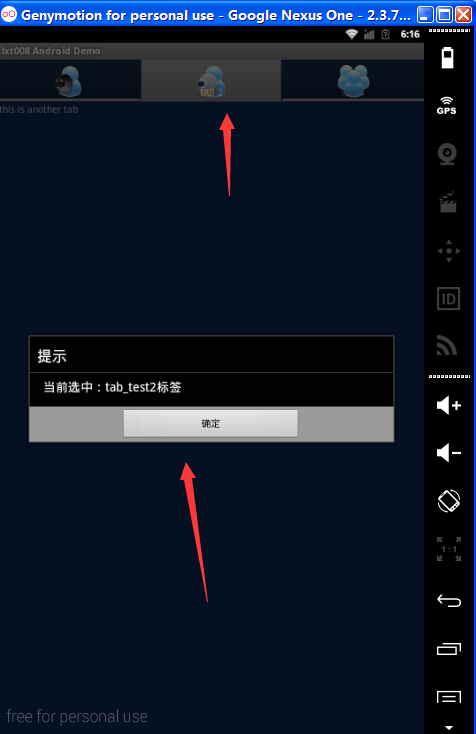
代码
package com.lxt008; import android.app.AlertDialog; import android.app.Dialog; import android.app.TabActivity; import android.content.DialogInterface; import android.graphics.Color; import android.os.Bundle; import android.widget.TabHost; import android.widget.TabHost.OnTabChangeListener; public class Activity01 extends TabActivity { //声明TabHost对象 TabHost mTabHost; /** Called when the activity is first created. */ @Override public void onCreate(Bundle savedInstanceState) { super.onCreate(savedInstanceState); setContentView(R.layout.main); //取得TabHost对象 mTabHost = getTabHost(); /* 为TabHost添加标签 */ //新建一个newTabSpec(newTabSpec) //设置其标签和图标(setIndicator) //设置内容(setContent) mTabHost.addTab(mTabHost.newTabSpec("tab_test1") .setIndicator("TAB 1",getResources().getDrawable(R.drawable.img1)) .setContent(R.id.textview1)); mTabHost.addTab(mTabHost.newTabSpec("tab_test2") .setIndicator("TAB 2",getResources().getDrawable(R.drawable.img2)) .setContent(R.id.textview2)); mTabHost.addTab(mTabHost.newTabSpec("tab_test3") .setIndicator("TAB 3",getResources().getDrawable(R.drawable.img3)) .setContent(R.id.textview3)); //设置TabHost的背景颜色 mTabHost.setBackgroundColor(Color.argb(150, 22, 70, 150)); //设置TabHost的背景图片资源 //mTabHost.setBackgroundResource(R.drawable.bg0); //设置当前显示哪一个标签 mTabHost.setCurrentTab(0); //标签切换事件处理,setOnTabChangedListener mTabHost.setOnTabChangedListener(new OnTabChangeListener() { // TODO Auto-generated method stub @Override public void onTabChanged(String tabId) { Dialog dialog = new AlertDialog.Builder(Activity01.this) .setTitle("提示") .setMessage("当前选中:"+tabId+"标签") .setPositiveButton("确定", new DialogInterface.OnClickListener() { public void onClick(DialogInterface dialog, int whichButton) { dialog.cancel(); } }).create();//创建按钮 dialog.show(); } }); } }
布局文件
<?xml version="1.0" encoding="utf-8"?> <TabHost xmlns:android="http://schemas.android.com/apk/res/android" android:id="@android:id/tabhost" android:layout_width="fill_parent" android:layout_height="fill_parent"> <LinearLayout android:orientation="vertical" android:layout_width="fill_parent" android:layout_height="fill_parent"> <TabWidget android:id="@android:id/tabs" android:layout_width="fill_parent" android:layout_height="wrap_content" /> <FrameLayout android:id="@android:id/tabcontent" android:layout_width="fill_parent" android:layout_height="fill_parent"> <TextView android:id="@+id/textview1" android:layout_width="fill_parent" android:layout_height="fill_parent" android:text="this is a tab" /> <TextView android:id="@+id/textview2" android:layout_width="fill_parent" android:layout_height="fill_parent" android:text="this is another tab" /> <TextView android:id="@+id/textview3" android:layout_width="fill_parent" android:layout_height="fill_parent" android:text="this is a third tab" /> </FrameLayout> </LinearLayout> </TabHost>